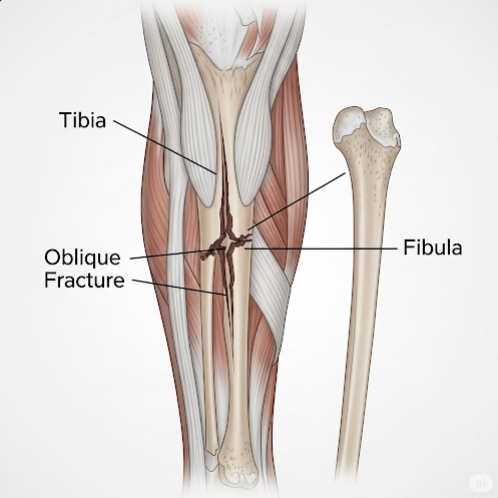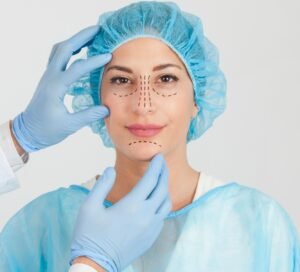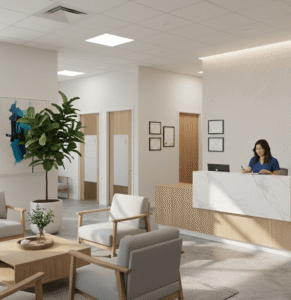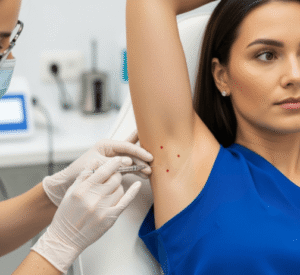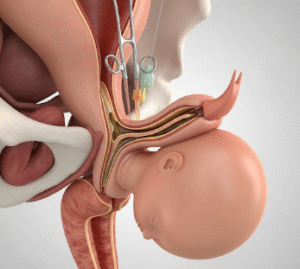Overview
An oblique fracture is a type of bone break where the fracture line runs diagonally across the bone, typically at an angle to the bone’s long axis. It usually occurs in long bones, such as the femur (thigh), tibia (shin), humerus (upper arm), or radius (forearm). Oblique fractures are commonly caused by a sharp, angled force or twisting injury, and they can vary in severity from stable to displaced or even compound (open).
Because of the diagonal break, oblique fractures are often less stable than transverse fractures and may require surgical intervention for proper alignment and healing.
What is an Oblique Fracture?
An oblique fracture occurs when the bone breaks at an angle, typically ranging between 30 to 60 degrees across the shaft of the bone. It differs from:
- Transverse fractures (straight across)
- Spiral fractures (curved break due to twisting)
- Comminuted fractures (bone shatters into pieces)
Oblique fractures can be:
- Stable: Bone ends remain aligned
- Unstable/displaced: Bone ends shift and may require realignment
- Open (compound): Bone pierces the skin, increasing risk of infection
Prompt treatment is crucial to prevent improper healing, chronic pain, or mobility issues.
Symptoms
Symptoms of an oblique fracture are typically acute and may include:
- Sudden, severe pain at the site of injury
- Swelling and bruising
- Deformity or angulation of the affected limb
- Tenderness to touch
- Inability to move or bear weight
- Grinding or popping sensation during movement
- Visible bone (in open fractures)
Pain often increases with movement or pressure, and function may be immediately impaired.
Causes
Oblique fractures are usually the result of a force applied at an angle to the bone, often during:
- Falls from a height or while playing sports
- Twisting injuries (e.g., skiing, basketball, or martial arts)
- Direct trauma from motor vehicle accidents or industrial incidents
- Contact sports involving tackles or collisions
- Osteoporosis or weakened bones, making bones more vulnerable to angled breaks
Risk Factors
Certain conditions increase the risk of sustaining an oblique fracture:
- High-impact sports or physical activities
- Poor bone density (osteoporosis, aging)
- Previous fractures or bone disease
- Vitamin D or calcium deficiency
- Unsafe environments (slippery floors, poor lighting)
- Neurological conditions causing balance or coordination issues
Children and older adults are especially at risk due to bone fragility or accidental falls.
Complications
If not treated properly, oblique fractures can lead to:
- Malunion (bone heals in incorrect position)
- Nonunion (failure of bone to heal)
- Infection, particularly in open fractures
- Chronic pain or instability
- Limb shortening or deformity
- Nerve or blood vessel damage
- Compartment syndrome (rare but serious swelling that cuts off circulation)
Proper diagnosis and treatment are essential to restore full function.
Prevention
While accidents can’t always be avoided, the following steps can reduce the risk of oblique fractures:
- Use protective gear during sports and physical labor
- Ensure safe environments (non-slip flooring, handrails)
- Regular weight-bearing exercise to strengthen bones
- Adequate calcium and vitamin D intake
- Fall prevention strategies for the elderly (balance training, medication review)
- Bone density testing for individuals at risk of osteoporosis
Treatment Options in Korea
South Korea provides world-class orthopedic care for all types of fractures, including oblique fractures, through advanced hospitals and orthopedic centers.
1. Diagnosis
- Physical examination for deformity and mobility
- X-rays to confirm fracture pattern and displacement
- CT or MRI scans if soft tissue or joint involvement is suspected
- Blood tests (for open fractures or underlying bone conditions)
2. Non-Surgical Treatment
Suitable for stable or non-displaced fractures:
- Immobilization with cast or splint
- Crutches or assistive devices to avoid weight-bearing
- Pain management (NSAIDs, acetaminophen)
- Regular follow-up X-rays to monitor healing
3. Surgical Treatment
Required for displaced, unstable, or open fractures:
- Open Reduction and Internal Fixation (ORIF)
- Bone is realigned and fixed with plates, screws, or rods
- External fixation in complex or compound fractures
- Wound debridement and antibiotics in open fractures
4. Rehabilitation and Recovery
- Physiotherapy to restore strength, flexibility, and range of motion
- Gradual weight-bearing as advised by the orthopedic surgeon
- Occupational therapy if upper limbs are affected
- Monitoring for complications such as delayed healing or infection
5. Leading Hospitals in Korea
Top institutions for fracture care include:
- Seoul National University Hospital – Orthopedic Surgery Department
- Samsung Medical Center – Fracture and Trauma Center
- Asan Medical Center – Musculoskeletal Center
- Severance Hospital (Yonsei University)
- Wooridul Spine Hospital (for spinal fractures)
These hospitals offer:
- Advanced surgical techniques
- Multilingual staff and international patient services
- Customized rehabilitation programs
- Minimally invasive options for quicker recovery

